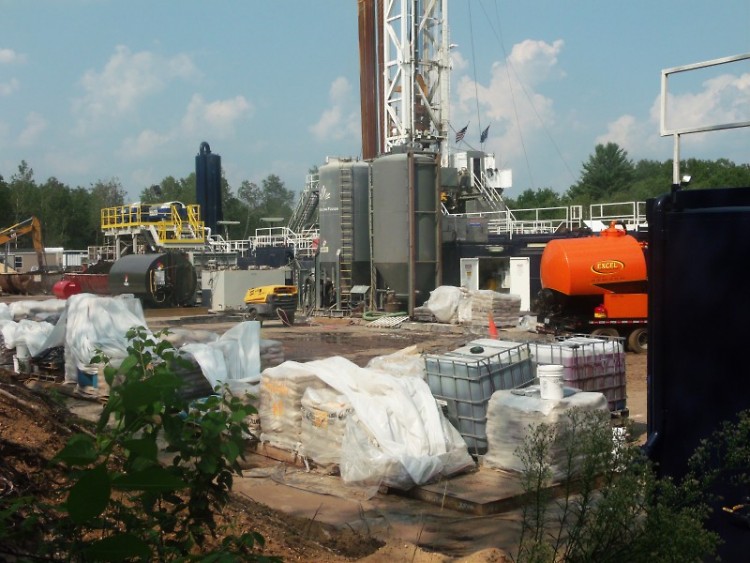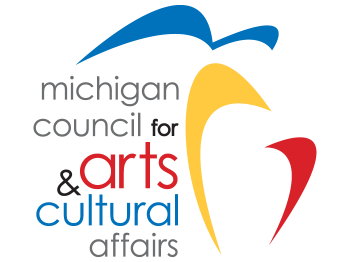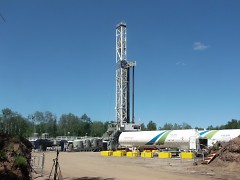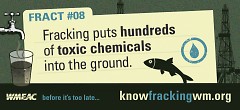Perhaps you’ve seen them: billboards that aim to educate the public about horizontal hydraulic fracturing or fracking, a relatively new process of oil and gas extraction from deep shale layers. These frack facts, 49 numbered “fracts” as sponsoring organization West Michigan Environmental Action Council calls them, offer quick and often quantifiable slices of information about the process of fracking, from the average number of tanker trucks needed to transport the chemicals, acids and lubricants used to drill and frack a well, to the millions of gallons of fresh water used to pump fracking’s slurry of water, chemicals, sand and proppants through one to two mile long horizontal well bores 5,000-10,000 feet below the surface, to concerns about the potential for methane and toxins to migrate beyond the well bore when fracking fluid is pumped at high pressure into fissures or fractures in deep shale layers, to release “tight” or trapped gas and oil.
Signs of growing interest, whether supportive or critical of fracking, seem to be everywhere: in economic reports, in scientific studies, in Bill McKibben’s Do the Math Tour, in a coalition of Michigan activist organizations calling for protest of the Michigan Department of Natural Resource’s next Oil and Gas Leasing Auction on May 9 and in the local coverage of a recent meeting introducing west Michigan to its newest frack well site in Muskegon county.
At the federal level, our government has turned its attention toward the “shale gas revolution” as a way to free America from its dependence on foreign oil, while Governor Snyder’s office and the Michigan State Legislature seem equally eager to promote relatively new and unconventional methods of oil and gas extraction such as fracking and carbon dioxide injection. Yet environmental advocacy groups such as WMEAC and a growing number of west Michigan citizens and activists are not exactly welcoming what our State House, in its May 2012 Energy and Jobs Creation Report (also called the Natural Gas Subcommittee report) hail as the “natural gas renaissance [that is] upon us.”
The report claims that increasing Michigan’s extraction, production, and transport of natural gas will create “thousands of energy jobs throughout our state” which would “generate $2 billion in economic activity, making Michigan a key producer.” The Subcommittee makes several suggestions for increasing oil and gas development on public land, advising the Michigan Department of Natural Resources (MDNR) to lease all of Michigan’s remaining public land – over 5 million unleased acres – and calling attention to the potential for stricter environmental regulations in the future, citing a desire to “ensure that federal officials know that the State of Michigan has numerous concerns with the EPA’s [regulatory] proposals.”
In response to the State’s endorsement of horizontal hydraulic fracturing as a safe and economical way to boost Michigan’s economic future, several new citizen activist groups – as WMEAC’s bill board campaign illustrates – are challenging what State legislators and regulators refer to as “safe fracking.” A quick conversation with any of the four area “fractivists” featured in this brief series of articles brings up a host of studies from states years ahead of us in the shale-gas and shale-oil boom.
Sarah Barker, a GRCC student and local musician who has visited several frack well sites around the state, attempts to communicate the sensory experience and the changes that occur to the landscape through her songs. She points to the ecological damage, citing the work of Pennsylvania restoration ecologist Kevin Heatley, who presented (via Skype) at the March 16 “Save Our State” event in Lansing that Barker co-organized with Clean Water Action’s Kate Holloway. “Fracking is a distributed, industrialized system – in the forest,” Heatley says, having experienced the fracking boom that has swept across Pennsylvania’s Marcellus shale. “The industry is right about one thing,” Heatley noted at the March 16 event. “Fracking is going to fundamentally change the landscape. It will change everything you know about your home, your community, and your water, and you’d better be ready.”
Steve Losher, the president of a group formed after several of its Allegan and Barry County members attended the MDNR’s May 2012 Mineral Rights auction, whereby Barry County’s State Game and Yankee Springs Recreation Areas were leased for oil and gas development, cites studies such as Duke University’s study of drinking water contamination following natural gas drilling (fracking), which reveals that drinking water wells near frack well sites have concentrations of methane that are 17 times higher than wells not in close proximity to fracking operations. He also mentions Dr. Anthony Ingraffea of New York’s Cornell University, an engineering professor and researcher who presents study after study (and several YouTube presentations) showing that the cement and steel casings the industry and state regulatory agencies tout as safe, can indeed leak and do leak at a rate of 6-12% of wells studied.
Nicole Berens-Capizzi, a social worker and active member of Mutual Aid GR, directs her interest to animal and public health concerns, calling attention to studies that seem to indicate that in terms of humans, women (based on research on breast cancer rates) may be most susceptible to the effects of carcinogens used in the fracking process, and that domestic and wild animals also seem to suffer at high rates. Issues of social and environmental justice, for this graduate of Grand Valley State who majored in sociology, prevail.
And finally, Jeff Smith, founder of local independent media outlet Grand Rapids Institute for Information Democracy, discusses fracking as just one of the many problems associated with our country’s addiction to fossil fuels and the failure of mainstream media outlets to provide the public with in-depth information on climate change, the environmental impacts of oil and gas extraction, and the social injustices surrounding oil and gas industry practices.
As area residents learn more about the MDNR’s leasing of several Kent County parks and recreation areas and the Michigan Department of Environmental Quality’s approval of a growing number of frack well sites around the state (the MDEQ Office of Oil and Gas regulates and permits all wells in the state), this brief series on fractivism offers only a hint of the local, regional, and national concern rising up around fracking, and the whole new crop of citizen researchers and activists organizing to address public concerns.
As WMEAC’s billboards and growing protests draw more and more people into the conversation, those concerned about the potential consequences of fracking may find themselves considering one of three approaches united under goal-oriented lists on the “Know Fracking West Michigan…before it’s too late” website: "Educate, Regulate, Eliminate."
Disclosure: Maryann Lesert is an author and Associate Professor of English at GRCC who has been researching fracking for a book-length environmental writing project. She has visited several well sites around the state and has given public presentations on the environmental dangers of fracking.
The Rapidian, a program of the 501(c)3 nonprofit Community Media Center, relies on the community’s support to help cover the cost of training reporters and publishing content.
We need your help.
If each of our readers and content creators who values this community platform help support its creation and maintenance, The Rapidian can continue to educate and facilitate a conversation around issues for years to come.
Please support The Rapidian and make a contribution today.



